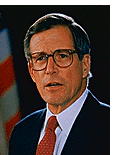 On education, there are big differences between Obama and Romney.
On education, there are big differences between Obama and Romney.
Commentary by Pete du Pont
June 27, 2012
Source: The Wall Street Journal
Much has been written about the choice we face just 19 weeks from now, when we will select the next president. But while we discuss the almost polar opposite views of Barack Obama and Mitt Romney on spending, regulation, taxes and health care, we shouldn’t lose sight of another very important issue: education.
While the candidates have some areas of agreement, their beliefs about education are still quite different, and the impact on our nation’s youth of a second Obama term versus a first Romney term would be significant. Not surprisingly, given their differences on most other issues, Mr. Obama’s approach more closely follows the status quo, proteachersunion track, while Mr. Romney’s more closely follows the reform, pro student track. Mr. Romney’s plan includes vouchers that would give disadvantaged children, particularly those in failed schools, and their parents the option of moving to a school of their choice.
In the past, decisions on where children went to school would usually depend primarily upon their ZIP code. Giving parents choices is important, perhaps now more than ever, because we can see it working in many places where it has been tried.
Heritage Foundation education researcher Lindsey Burke speaks of the Florida Tax Credit Scholarship Program, which provides school vouchers to lowincome children coupled with a tax credit to corporations that contribute funds. Ms. Burke cites the efforts of Northwestern University’s David Figlio, who studied the impact of competition resulting from the Florida program. He found that “greater degrees of competition are associated with greater improvements in students’ test scores following the programs introduction.”
Ms. Burke notes the District of Columbia Opportunity Scholarship Program, where vouchers are provided to lowincome children. Those who used a voucher to attend a private school had a 91% graduation rate compared with a 55% rate for students at the district’s public schools.
“There is far more evidence in support of school choice than there is evidence in support of a further centralized education agenda,” Ms. Burke notes. She cites Mr. Romney’s statement that “a choice for every parent means a chance for every child.”
Greg Forster of the Foundation for Educational Choice put together a good education analysis in the spring of 2011 titled “A WinWin Solution: The Empirical Evidence on School Vouchers.”Of 19 empirical studies of voucher programs, nine` show that “vouchers improve student outcomes, six that all students benefit, and three that some benefit and some are not affected,” Mr. Forster notes. Only one study “shows no visible impact,” and “none of the studies finds a negative impact.”
What’s more, competition works. Eighteen of the 19 studies found that “vouchers improved public schools” as well as helping students in private ones, and the remaining study found no impact, so that no study found a negative impact on public schools either.
“Every empirical study ever conducted in Milwaukee, Florida, Ohio, Texas, Maine, and Vermont finds that voucher programs in those places improved public schools,” Mr. Foster writes. Only one study, in the District of Columbia, failed to find a benefit for the schools, and Mr. Forster noted that is because Washington was the only program that shielded public schools “from the impact of competition.”
And voucher programs on the schools have “historically improved public schools financially. From 1990 to 2006, the nation’s school choice programs saved $422 million for local school districts and $22 million for state budgets.” A privateschool tuition voucher typically costs less than a public-school edcuation, so “public schools are left with more money to serve the students who remain.”
Choice benefits all. It allows parents to find the right school for each child. Even more important, it empowers them to hold schools accountable for their performance. This is why much of Mr. Romney’s education policy includes expanded choice, not just with vouchers, but also expanded opportunities for charter schools and other options, and better information so parents can make better choices.
So the important question concerning education performance in the future likely depends upon who the next president turns out to be. Mr. Obama, while deserving credit for having pushed some reforms, generally believes in maintaining the status quo, a view influenced no doubt by support from the teachers unions. Or, as Mr. Romney sums up the president’s view, “Don’t mend it, just spend it.”
Mr. Obama tried to eliminate funding for the District of Columbia’s scholarship program. Students in were fortunate that Speaker John Boehner and Sen. Joseph Lieberman worked out a deal with the Department of Education to continue it
Of course, the president, Congressional liberals and teachers union leaders have the freedom to send their own children to private schools while denying the same opportunity to lower-income kids in failing schools. It’s time to change that.
0 Comments